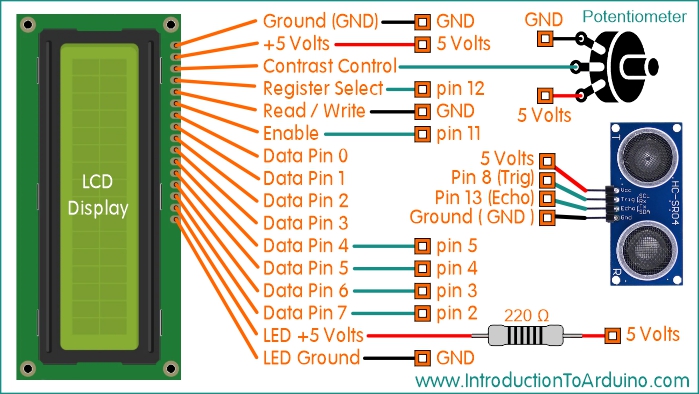
The readout for this project consists of two lines; the first showing the distance in centimeters and the second showing the distance in inches. If you have not already done so, you need to install a library. These are easy to install and only need to be installed once. Go to Tools / Manage Libraries and search for (and install) LiquidCrystal.
1 1602 (16x2) LCD Display 1 220 Ohm Resistor 1 Potentiometer 1 Arduino UNO R3 1 Breadboard Connector Wires
Code:
//------------- Code Starts Here ----------------------------
//-----------------------------------------
//Published by IntroductionToArduino.com
//Created by Paul Illsley (www.paulillsley.com)
//Please use and share so others can enjoy
//-----------------------------------------
// including the LiquidCrystal library
#include <LiquidCrystal.h>
// assigning LCD pins to arduino pin numbers
const int rs = 12;
const int en = 11;
const int d4 = 5;
const int d5 = 4;
const int d6 = 3;
const int d7 = 2;
LiquidCrystal lcd(rs, en, d4, d5, d6, d7);
// creating variables for the ultrasonic sensor data and assigning them to specific pins
int trigger_pin = 8;
int echo_pin = 13;
// creating variables for distance calculations to be preformed later
float duration;
float cm;
float inches;
void setup()
{
// set up serial monitor at a baud rate of 9600
Serial.begin (9600);
// declaring the pin modes (trigger_pin and echo_pin) as either output or input
pinMode(trigger_pin, OUTPUT);
pinMode(echo_pin, INPUT);
}
void loop()
{
// activating the ultrasonic sensor to collect pulse length data
digitalWrite(trigger_pin, LOW);
delayMicroseconds(1);
digitalWrite(trigger_pin, HIGH);
delayMicroseconds(1);
digitalWrite(trigger_pin, LOW);
// placing the pulse length data in the "duration" variable
duration = pulseIn(echo_pin, HIGH);
// calculate the distances from the pulse length data
cm = (duration/2) / 29.1;
inches = (duration/2) / 74;
// sending the raw and calculated distances (cm and inches) to the serial monitor
// you don’t need to use this section if you don’t want to view your data on your computer
Serial.print("duration(ms):");
Serial.print(duration);
Serial.print(", cm:");
Serial.print(cm);
Serial.print(", inches:");
Serial.print(inches);
Serial.println();
// declaring the number of columns and rows in the LCD (16 characters and 2 rows)
lcd.begin(16, 2);
// set the cursor location to column 0, line 0 (this is the first line)
// print text with calculated distance (cm)
lcd.setCursor(0, 0);
lcd.print("cm = ");
lcd.print(cm);
// set the cursor location to column 0, line 1 (this is the second line)
// print text with calculated distance (inches)
lcd.setCursor(0, 1);
lcd.print("inches = ");
lcd.print(inches);
// delay 1000 milliseconds (1 second) to make the display easier to read (you can change this value)
delay(1000);
}
Return to www.introductiontoarduino.com
|
